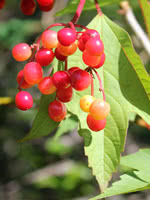Mon-Fri 9am - 5pm Mountain time
Redwing Highbush Cranberry vs Grouseberry
Viburnum trilobum JN Select
Vaccinium scoparium
NOT AVAILABLE THIS SEASON - MIGHT RETURN
CUSTOM GROW
The Redwing Highbush Cranberry is a dense multi-stemmed shrub that blooms with white pinwheel shaped flowers in spring. It produces small, red, and edible berries in late summer. Its leaves are green, but the tips become more saturated with red throughout the season, and then turn a stunning crimson colour in the fall.
The Redwing Highbush Cranberry makes a good addition to any urban garden or hedge, and its berries are commonly used to liven up preserves with their tart flavor.
Grouseberry is a native, low-growing deciduous shrub known for its edible red berries. In early summer, it produces small, urn-shaped flowers ranging from white to pink that attract bees and other pollinators. The berries provide an important food source for many types of wildlife, including game birds such as grouse, which gives the plant its common name. People can also enjoy the berries fresh or in baked goods, though they can be difficult to harvest in large quantities.
Spreading by rhizomes, Grouseberry forms dense, broom-like mats that help stabilize soil and prevent erosion, while also providing cover for ground-nesting wildlife. It is commonly found beneath conifers in open forests, subalpine meadows, and occasionally on rocky slopes in mountainous regions. It is well-suited for naturalization, ecological restoration, and soil stabilization projects.

